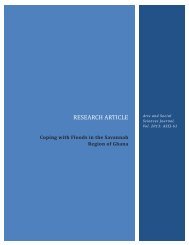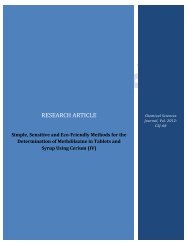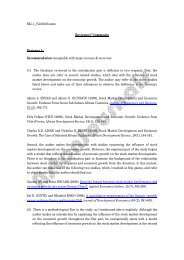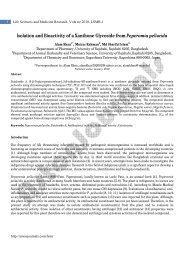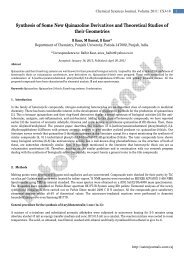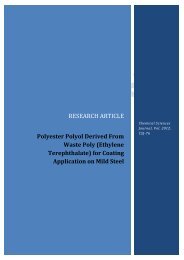An Efficient Synthesis of Biologically Active ... - AstonJournals
An Efficient Synthesis of Biologically Active ... - AstonJournals
An Efficient Synthesis of Biologically Active ... - AstonJournals
You also want an ePaper? Increase the reach of your titles
YUMPU automatically turns print PDFs into web optimized ePapers that Google loves.
4 Research Article2.3.9. 3-Hydroxyphenyl(1H,3H)tetrachloroquinazolin-2,4-dione (3c)Grey crystal (0.45 gm, 81%), m.p. 308–3098C. FT-IR (KBr, cm 21 ): 3472 (ν OH), 3200 (ν NH), 1726, 1664 (ν C5O’s).1H NMR spectrum: (300 MHz, DMSO-d6): 6.8–7.1 (2d, 4H, A 2B 2arom.); 9.65 (s, 1H, OH); coupling constant for aromaticprotons 5 0.0008 Hz, 11.2 (s, 1H, NH). MS (m/z, %): 390 (M 1 ) in addition to the characteristic peaks forcompounds containing four chlorine atoms at (M12), (M14) and (M16). <strong>An</strong>al. calcd. for C 14H 6Cl 4N 2O 3: C, 42.90%;H, 1.54%; N, 7.14%. Found: C, 43.02%; H, 1.55%; N, 7.17%.2.3.10. 3-<strong>An</strong>isidyl(1H,3 H)tetrachloroquinazolin-2,4-dione (3d)Buff crystal (0.49 gm, 83%), m.p. 312–3148C. FT-IR (KBr, cm 21 ): 3196 (ν NH), 3001 (ν CH arom.), 2227 (ν CH aliph.),1746, 1669 (ν C5O’s). 1 H NMR spectrum: (300 MHz, DMSO-d6): 3.8 (s, 3H, OCH 3); 7.0–7.24 (2d, 4H,A 2B 2arom.);coupling constant for aromatic protons 5 0.00077 Hz, 11.2 (s, 1H, NH). MS (m/z, %): 404 (M 1 ) in addition to thecharacteristic peaks for compounds containing four chlorine atoms at (M12), (M14) and (M16). <strong>An</strong>al. calcd. forC 15H 8Cl 4N 2O 3: C, 44.37%; H, 1.99%; N, 6.90%. Found: C, 44.62%; H, 2.01%; N, 7.00%.2.3.11. 3-Chlorophenyl(1H,3H)tetrachloroquinazolin-2,4-dione (3e)White crystal (0.55 gm, 67%), m.p. 320–3228C. 1 H NMR spectrum: (300 MHz, DMSO-d6): 7.3–7.6 (2d, 4H,A 2B 2arom.); coupling constant for aromatic protons 5 0.00088 Hz, 11.3 (s, 1H, NH). MS (m/z, %): 408 (M 1 ) in additionto the characteristic peaks for compounds containing four chlorine atoms at (M12), (M14) and (M16). <strong>An</strong>al.calcd. for C 14H 5Cl 5N 2O 2: C, 40.98%; H, 1.23%; N, 6.82%. Found: C, 41.16%; H, 1.24%; N, 6.95%.2.3.12. 3-Acetophenyl(1H,3H)tetrachloroquinazolin-2,4-dione (3f)Yellow crystal (0.3 gm, 65%), m.p. 210–2128C. FT-IR (KBr, cm 21 ): 3231 (ν NH), 3057 (ν CH arom.), 2919 (ν CHaliph.), 1740, 1660 (ν C5O’s). 1 H NMR spectrum: (200 MHz, DMSO-d6): 2.6 (s, 3H, CH 3); 7.5–8.1(2d, 4H, A 2B 2arom.);coupling constant for aromatic protons 5 0.0031 Hz, 11.4 (s, 1H, NH). MS (m/z, %): 416 (M 1 ) in addition to thecharacteristic peaks for compounds containing four chlorine atoms at (M12), (M14) and (M16). <strong>An</strong>al. calcd. forC 16H 8Cl 4N 2O 3: C, 45.98%; H, 1.92%; N, 6.70%. Found: C, 46.35%; H, 1.94%; N, 6.92%.2.3.13. 3-Carboxyphenyl(1H,3H)tetrachloroquinazolin-2,4-dione (3g)White crystal (0.29 gm, 72%), m.p. 318–3198C. FT-IR (KBr, cm 21 ): 3395 (ν NH), highly bonded OH extending from3267–2724, 1740, 1660 (ν C5O’s). 1 H NMR spectrum: (200 MHz, DMSO-d6): 7.4–8.1(2d, 4H, A 2B 2arom.); couplingconstant for aromatic protons 5 0.0032 Hz, 11.4 (s, 1H, NH); 12.8 (broad s, 1H, COOH). MS (m/z, %): 418 (M 1 ) inaddition to the characteristic peaks for compounds containing four chlorine atoms at (M12), (M14) and (M16). <strong>An</strong>al.calcd. for C 15H 6Cl 4N 2O 4: C, 42.89%; H, 1.44%; N, 6.67%. Found: C, 43.28%; H, 1.45%; N, 6.98%.2.3.14. 3-Nitrophenyl(1H,3H)tetrachloroquinazolin-2,4-dione (3h)Yellow crystal (0.34 gm, 77%), m.p. 304–3068C. 1 H NMR spectrum: (300 MHz, DMSO-d6): 7.6–8.4 (2d, 4H, A 2B 2arom.);coupling constant for aromatic protons 5 0.0024 Hz, 11.4 (s, 1H, NH). <strong>An</strong>al. calcd. for C 14H 5Cl 4N 3O 4: C, 39.95%; H,1.19%; N, 9.91%. Found: C, 40.03%; H, 1.18%; N, 10.0%.2.3.15. <strong>An</strong>tibacterial studies<strong>An</strong>tibacterial activity was determined against the above-mentioned bacteria using the paper disk assay method [20] withWhatman No. 1 filter paper disk <strong>of</strong> diameter 6 mm, which was sterilized by autoclaving for 15 min at 1218C. The steriledisks were impregnated with different tested compounds (50 mg/ml). Agar plates were surface inoculated uniformly fromthe broth culture <strong>of</strong> the tested microorganisms. In all cases, the concentration was approximately 1.2 3 10 8 CFU/ml[21]. The impregnated disks were placed on the Muller Hinton medium suitably spaced apart, and the plates were incubatedat 378C for 24 h. Dimethylformamide (DMF) was used as negative control, while commercial antibiotic disks (tetracycline,30 mg/disk) were used as a positive control. The diameter <strong>of</strong> the growth inhibition halos caused by differentcompounds tested was measured by a ruler and expressed in millimeter. All the assays were carried out in triplicate.3. Results and Discussion3.1. <strong>Synthesis</strong>The synthesis <strong>of</strong> the compounds 2a–f and 3a–h resulted from three steps [22], sequence starting from tetrachlorophthalicanhydride followed by N-hydroxytetrachlorophthalimide, then N-phenylsulphonyloxytetrachlorophthalimide (1).http://astonjournals.com/csj



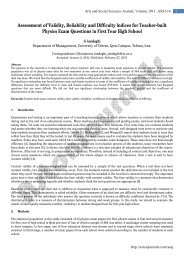
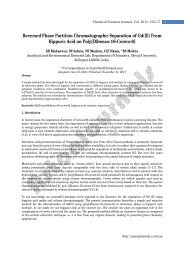
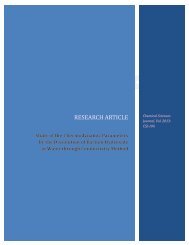
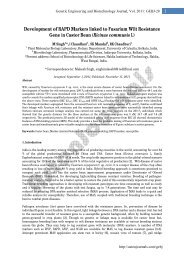

![[1,4]-benzodiazepine-2-one Derivatives as Potent - AstonJournals](https://img.yumpu.com/49117784/1/184x260/14-benzodiazepine-2-one-derivatives-as-potent-astonjournals.jpg?quality=85)
